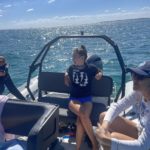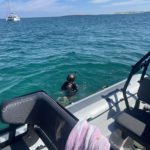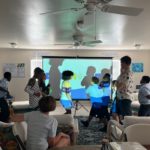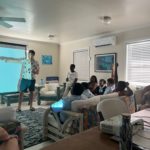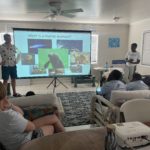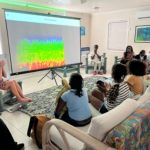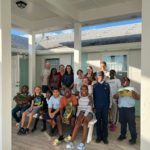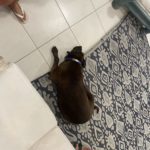The Sea of Abaco: Day 4
Day 4 in The Sea of Abaco began with a beautiful morning in the Marsh Harbour marina. Half of the group set off for a half-day on the boat to retrieve the acoustic recorder deployed at Sandy Cay on the first day, enjoy a snorkel at that reef, and hopefully see some dolphins. We began by scanning the marina from the docks and then aboard the Zodiac, looking for the mother-calf pair from yesterday. Not long after, a call came in over the VHF radio that 8 dolphins had been spotted near a boat anchorage in between the marina and Sandy Cay, so we sped off hopeful to intercept the dolphins before they headed off to deeper waters. When we arrived, we stopped and did our typical scan of the area with binoculars but unfortunately no dolphins were found.
Next, we headed onwards to Sandy Cay. Upon arrival, Charlotte hopped in the water to free dive to collect the recorder. She emerged with the recorder, which was affixed to half of a cinder block with zip ties, and we carefully hoisted it on board the boat. After that, we got in the water for a snorkel! The wind started to pick up, bringing in a big swell, which made for a brief, yet very enjoyable, snorkel. The reef is home to many large parrotfish nibbling on the corals and tall sea fans swaying in motion with the current. We saw a large pufferfish, a little green turtle, and even a giant (about 5-foot wide!) spotted eagle ray. After the snorkel, we warmed up in the sun and then started to head back to the marina. On the way, we stopped a few times to scan for dolphins. Once again, none were found. Nonetheless, it was an awesome day out on the water!
In the afternoon, the whole group was reunited back at the Friends of the Environment Frank Kenyon Center where we waited for the arrival of our exciting guests. Friends of the Environment hosts an Eco afternoon club for children three times a week. Today’s club was for children aged 9 to 11 from the local school. As part of our trip, we planned a lesson and activities for this group. Our program began with a lesson about marine mammals, quizzing the children on what defines a marine mammal (it breathes air, has hair, bears live young, produces milk, and depends on the ocean for its home and/or food) and which Bahamian species are in fact marine mammals (barracuda, no; bottlenose dolphin, yes). We used software to show the students the sounds they were making (which was a lot of sounds!) projected on the screen in front of them using a real-time spectrogram. A spectrogram visually displays sound as a function of its time, pitch, and loudness, (depicted by the color). The students enthusiastically stepped up to create sounds to display on the screen, and even to mimic the pre-recorded animal sounds we played for them. By the end, the students were able to expertly differentiate between a fish and a whale, and even replicate the sounds themselves! We finished the afternoon by creating our very own soundscape (an environment of sound) to replicate a rainstorm using snaps, claps, and stomps, and then by each being assigned a component of the marine environment (waves, sperm whales, snapping shrimp, and ships). Before leaving, the students recited their eco-pledge, stating their commitment to caring for nature, and we all took a group photo!
When evening rolled around, we enjoyed a delicious paella dish cooked up by Emily. Soon after, our neighbor at Friends of the Environment, Brian Kakuk, arrived to give us a talk on Bahamian Blue Holes and cave diving. Brian is the founder and director of the Bahamas Caves Research Foundation. In addition to his impressive National Geographic cover (ranked in the top 10 covers of all time! It makes great supplementary reading to this blog post and is linked below), Brain’s work has contributed to major advancements in cave-related science, including significant artefact, fossil, and both extinct and extant species discoveries, as well as conservation and protection measures. We also learned a lot about specific aspects of cave geology, chemistry, and biology. It was a privilege to have him come deliver a talk for us! After he and his lovely dog Otis headed back home, we finished off the day with fudge twirl ice cream!
Written by Grace Fogarty (University of St. Andrews)
- (From back to front) Sari, Grace, India, Vincent, and Jasmine getting ready to jump in the water for their snorkel!
- Charlotte (left), Grace (center), and India (right), enjoying the warm weather and stunning views from the boat at Sandy Cay reef.
- Charlotte enters the water, ready to retrieve the rope from the nearby mooring by hand! Both Charlotte and Diane are experienced diving, including in underwater caves.
- The students participating in an activity where they listen to a sound and then move to one side of the room or the other based on which of the two options they think made the sound.
- Tristan engaging the students with discussions about marine mammals.
- Tristan (left) and Le’Andra (right) showing the students examples of marine mammals.
- Emily guiding the group in creating a soundscape using claps and other motions. The projector screen shows the spectrogram displaying the sounds of claps. The horizontal axis is the time over which the sound is occurring, and the vertical axis is the pitch (how high or low in frequency the sound is) and color shows how loud the sound is. The kids loved trying to make the color as bright as possible and whistle to convey a fun pattern on the screen.
- Our group (back row) smiling with the Friends of the Environment Eco club!
- Otis the Blue Hole Dog relaxing in the living room as Brian Kakuk gives us his fascinating talk.

